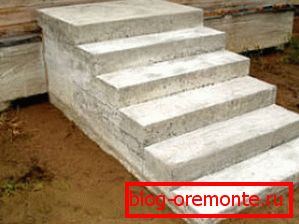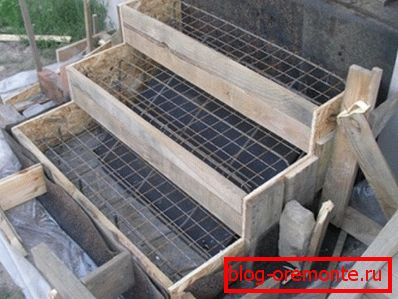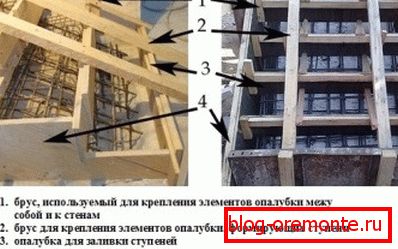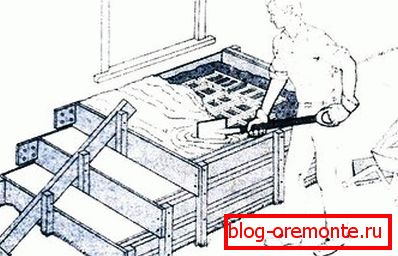How to independently pour the steps of concrete
The staircase is a mandatory attribute of almost any building that smoothly connects the ground level to the porch. Most staircases have a standard structure that consists of a certain number of steps and a porch area, if any. The material for its formation, everyone chooses based on their own preferences, but the best option for the street stairs are steps made of concrete.

The priority of using concrete for casting steps is due to the high technical characteristics of this material.
Unlike metal counterparts, concrete steps absorb the sound of steps and do not create a hum during walking, they are indifferent to:
- moisture,
- ultraviolet light
- acids,
- dryness
- other negative effects that are inevitable outdoors.

Concrete stairs are also distinguished by the versatility of finishing - you can make the lining with natural or artificial stone, ceramics, etc. At the same time, it does not require special care and rehabilitation procedures, unless, of course, you set yourself the goal of specifically damaging it. After installation and finishing of a concrete ladder, it will be enough only to do ordinary street cleaning from time to time.
Another significant advantage of concrete structures is the ability to fill the stairs with your own hands from concrete, that is, completely independently. Thus, you can significantly save money - on average, the price of the services of specialists is about 40% of the total cost of the material. In this article, you will be given detailed instructions on how to make steps from concrete.
Step Fill
Preparation of the base

Before pouring concrete steps, it is necessary to properly prepare the working area. Ordinary soil is not advisable to use as the basis for a concrete structure, as it tends to change its structure in the cold season.
During frosts, the ground freezes and frost heave occurs, which can lead to deformation of the stairs.
- First of all, the fertile soil layer is removed - all the soil that freezes through during the cold season should be removed.. Only in this way can you protect the structure from the effects of frost heaving. Minimally removed at least 30 cm of soil;
Note! In order to provide a reliable basis for the future construction, the ground removal area should slightly exceed the dimensions of the stairs. The minimum value is 10 cm around the perimeter of the site.
- A “cushion” of gravel forms in the formed pit, which will serve as the basis for concrete. It is advisable to select a gravel of the middle fraction, since too large elements will not lie evenly. After backfilling, the area is moistened, rammed and flattened to create a non-spillage coating;

- A layer of sand 3–5 cm thick is poured, which is covered with continuous waterproofing.. For this purpose, you can use dense polyethylene or roofing felt - it is important to brew / glue the seams so that no ground moisture can leak through them;
Reinforcement
Чтобы лестница не отделилась со временем от основной постройки, необходимо связать обе конструкции посредством металлических арматурных вставок. Чтобы вставить арматуру в фундамент, можно использовать алмазное бурение отверстий в бетоне, которое поможет вам без особых сложностей вживить штыри в стену (читайте также статью «Ступени для лестниц из бетона: основные характеристики и эксплуатационные особенности»).
The overall reinforcement of the structure is carried out according to the skeleton principle - the reinforcement fixes the main nodes of the stairs, and the periphery is covered with a metal grid.

Formwork assembly
The production of steps from concrete begins with the assembly of the formwork, which will give the cement mortar the desired shape.
Metal or wood can be used as a material for the frame - in this case, wood is preferable, since the staircase has a broken structure.
Note! If you want to save material, then before assembling the formwork, in the central part of the future staircase an elevation is formed from the gravel of the middle fraction - thus, you will spend much less cement mixture. The amount of backfill is calculated based on the fact that the layer of concrete anywhere in the structure must be at least 30 cm.
- First of all, formwork boards are assembled, which can either repeat the notches for the steps, or simply have an inclined shape. The difference between them lies only in the mounting options transverse elements. The framework must be strong enough to withstand the pressure of the cement mortar - the beads must be strong and have external stiffeners;

- As a temporary fixation of the front part of the board, metal or wooden stakes are used. The back of the board is fixed directly to the wall. During the installation of the formwork, it is important to observe the correctness of the geometry of the assembled figure - the slightest bias will become the property of the future ladder;
- Transverse elements are cut, by means of which gradients for steps are formed. The standard height of the steps is about 17 cm, and the width is 30 cm, however, you can choose the parameters based on your own preferences. The method of mounting the crossbars depends on the structures of the sidewalls - they are planted directly on the formed grooves, or fixed on squares and screws, if the sides have a solid structure;
- After the frame is fully assembled, it is wedged and abutted to prevent extrusion under the weight of the filled solution. The tops of the sidewalls are connected by transverse straps, and the sides themselves are fixed outside by oblique stops and stakes-pins.
Pouring concrete

The concrete solution consists of sand and a binder, which is played by Portland cement M400. It also includes gravel of the middle fraction - it plays the role of a filler, which increases the volume of the mixture and reduces the consumption of cement. The ratio of sand, cement and crushed stone in the solution is 2: 1: 3 based on the mass fraction of the components.
Water should be added to the solution only as much as is necessary to create a homogeneous mixture, it should be borne in mind that the less liquid enters the concrete, the stronger it will be.
After the cement mortar is fully mixed - you can start pouring. During casting, large stones can be thrown into the formwork, which will reduce the consumption of cement mixture.
After partial filling of the form, the formwork must be tapped to eliminate the appearance of voids in the concrete. Flooded form can be disassembled only after the concrete has dried at least 70%.

Total
Самостоятельная заливка ступеней бетоном позволяет существенно сэкономить средства и создать надежную конструкцию, которая прослужит вам верой и правдой много лет. Даже если по неопытности у вас возникла небольшая деформация - резка железобетона алмазными кругами поможет вам удалить погрешности (см.также статью «Железобетонные ступени: нормативные документы и особенности монтажа»).
More information on this topic can be obtained by viewing the video in this article.